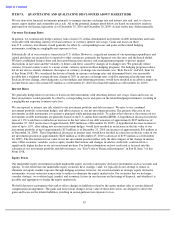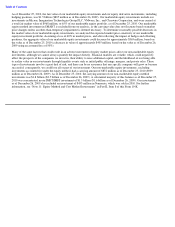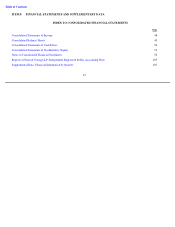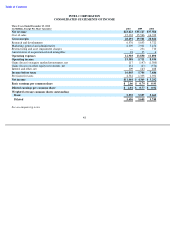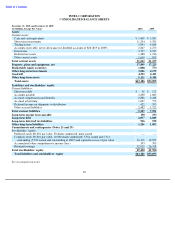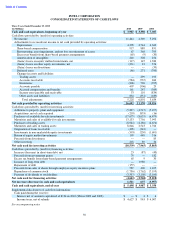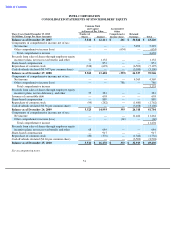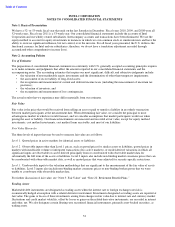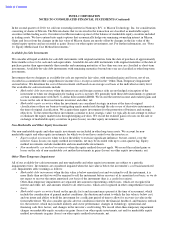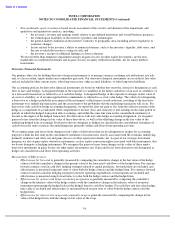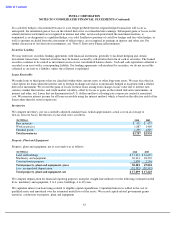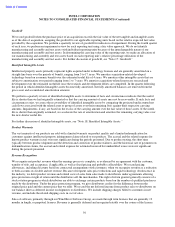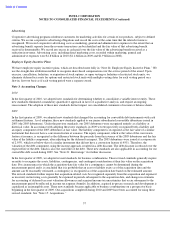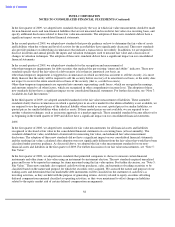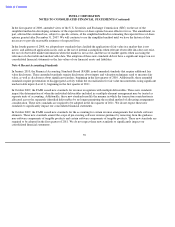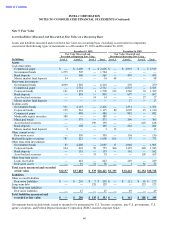Intel 2010 Annual Report Download - page 76
Download and view the complete annual report
Please find page 76 of the 2010 Intel annual report below. You can navigate through the pages in the report by either clicking on the pages listed below, or by using the keyword search tool below to find specific information within the annual report.
Table of Contents
INTEL CORPORATION
NOTES TO CONSOLIDATED FINANCIAL STATEMENTS (Continued)
In the second quarter of 2010, we sold our ownership interest in Numonyx B.V. to Micron Technology, Inc. for consideration
consisting of shares of Micron. The Micron shares that we received in the transaction are classified as marketable equity
securities within trading assets. Our interest in Micron makes up most of the balance of marketable equity securities included
in trading assets. We have entered into equity options that economically hedge our remaining ownership interest in Micron.
Gains and losses from the changes in the fair value of Micron shares are mostly offset by changes in the fair value of the
related equity options and are recorded as gains (losses) on other equity investments, net. For further information, see “Note
11: Equity Method and Cost Method Investments.”
Available
-for-Sale Investments
We consider all liquid available-for-sale debt instruments with original maturities from the date of purchase of approximately
three months or less to be cash and cash equivalents. Available-for-sale debt instruments with original maturities at the date of
purchase greater than approximately three months and remaining maturities of less than one year are classified as short-term
investments. Available-for-sale debt instruments with remaining maturities beyond one year are classified as other long-term
investments.
Investments that we designate as available-for-sale are reported at fair value, with unrealized gains and losses, net of tax,
recorded in accumulated other comprehensive income (loss), except as noted in the “Other-Than-Temporary Impairment”
section below. We determine the cost of the investment sold based on an average cost basis at the individual security level.
Our available-for-sale investments include:
Non
-Marketable and Other Equity Investments
Our non-marketable equity and other equity investments are included in other long-term assets. We account for non-
marketable equity and other equity investments for which we do not have control over the investee as:
Other-Than-Temporary Impairment
All of our available-for-sale investments and non-marketable and other equity investments are subject to a periodic
impairment review. Investments are considered impaired when the fair value is below the investment’s cost basis/amortized
cost. Impairments affect earnings as follows:
•
Marketable debt instruments
when the interest rate and foreign currency risks are not hedged at inception of the
investment or when our designation for trading assets is not met. We generally hold these debt instruments to generate
a return commensurate with the U.S.-dollar three-month LIBOR. We record the interest income and realized gains and
losses on the sale of these instruments in interest and other, net.
•
Marketable equity securities
when the investments are considered strategic in nature at the time of original
classification or there are barriers to mitigating equity market risk through the sale or use of derivative instruments at
the time of original classification. We acquire these equity investments for the promotion of business and strategic
objectives. To the extent that these investments continue to have strategic value, we typically do not attempt to reduce
or eliminate the equity market risks through hedging activities. We record the realized gains or losses on the sale or
exchange of marketable equity securities in gains (losses) on other equity investments, net.
•
Equity method investments
when we have the ability to exercise significant influence, but not control, over the
investee. Gains (losses) on equity method investments, net may be recorded with up to a one-quarter lag. Equity
method investments include marketable and non
-
marketable investments.
•
Non
-marketable cost method investments when the equity method does not apply. We record the realized gains or
losses on the sale of non
-
marketable cost method investments in gains (losses) on other equity investments, net.
•
Marketable debt instruments
when the fair value is below amortized cost and we intend to sell the instrument, it is
more likely than not that we will be required to sell the instrument before recovery of its amortized cost basis, or we do
not expect to recover the entire amortized cost basis of the instrument (that is, a credit loss exists).
Other-than-temporary impairments are separated into amounts representing credit losses, which are recognized in
interest and other, net, and amounts related to all other factors, which are recognized in other comprehensive income
(loss).
•
Marketable equity securities
based on the specific facts and circumstances present at the time of assessment, which
include the consideration of general market conditions, the duration and extent to which the fair value is below cost,
and our intent and ability to hold the investment for a sufficient period of time to allow for recovery in value in the
foreseeable future. We also consider specific adverse conditions related to the financial health of, and business outlook
for, the investee, which may include industry and sector performance, changes in technology, operational and
financing cash flow factors, and changes in the investee’s credit rating. We record other-than-temporary impairment
charges on marketable equity securities in gains (losses) on other equity investments, net and for marketable equity
method investments in gains (losses) on other equity method investments, net.


